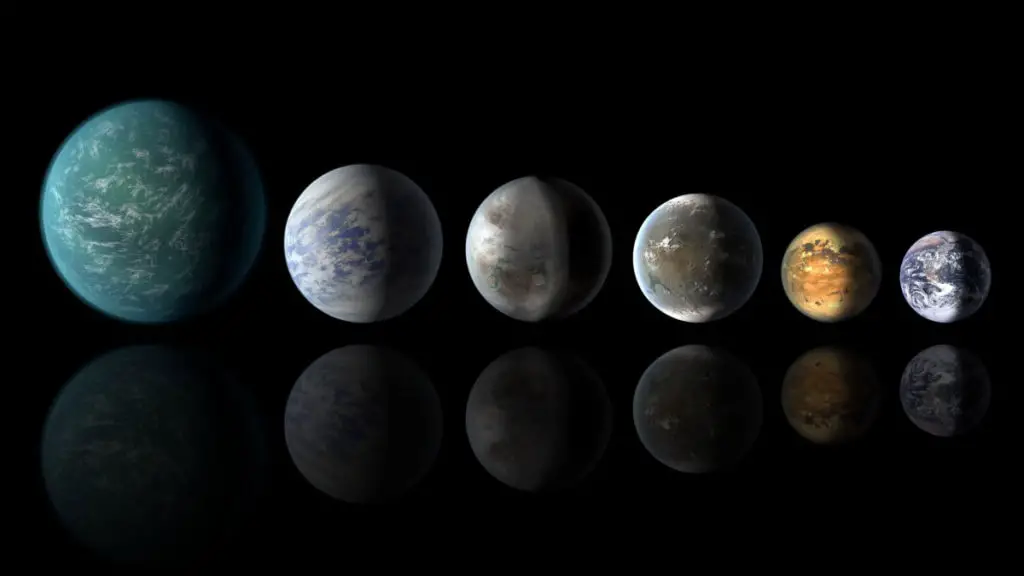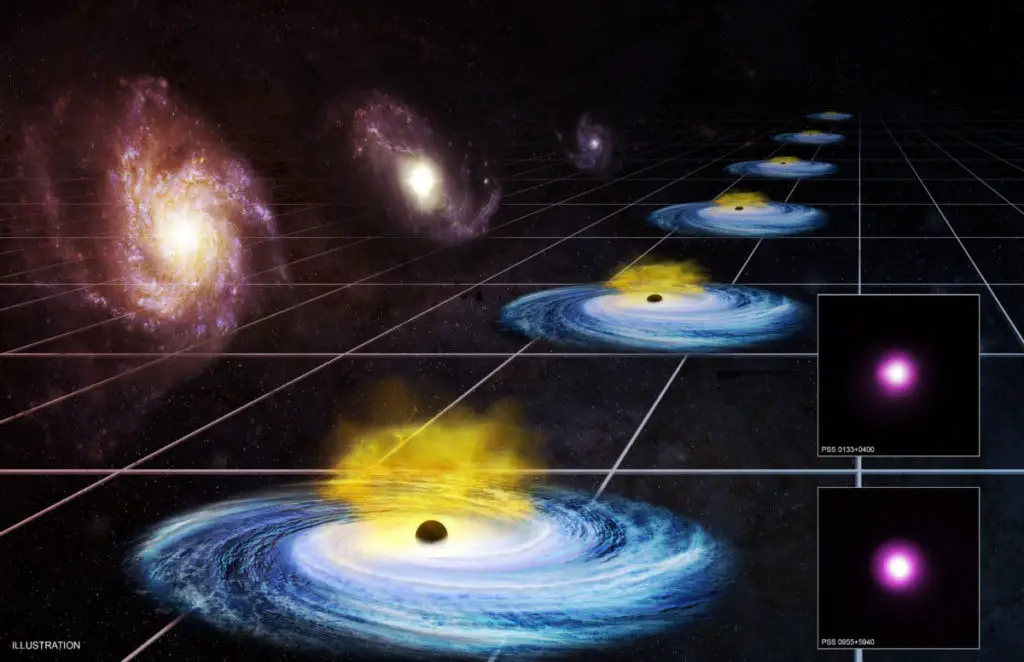
6. The Super-Earths Theory
As defined by NASA, a Super-Earth is a class of planets that are more massive than Earth yet lighter than the ice giants like Neptune and Uranus. They can be made of gases, rocks, or a combination of both. And they can be up to twice the size of Earth and 10 times its mass!
But even with a name like Super-Earth, there is very little to suggest they are anything like our home planet. The ‘Earth’ part of the term only serves to reference their size compared to Earth.
Our current number of confirmed discoveries for these exoplanets are 1342.

Image by NASA/Ames/JPL-Caltech
What do these planets have to do with aliens?
To understand the relation between Super-Earths and aliens, we have to first start with the discovery of the planet TOI-561b.
The planet TOI-561b is approximately 280 light-years away from our solar system. It is an exoplanet with a size 50% larger than Earth and three times its mass. The star TOI-561b orbits lie in the Milky Way’s “thick disk”, which generally contains stars around 10 billion years old, and scientists believe TOI-561b is just as ancient.
Unfortunately, this exoplanet is unlikely to host life because the approach of its orbit strays too close to its star, which results in a surface temperature of more than 3000 degrees Fahrenheit that ends up turning its top layer of rocks into molten magma.
Despite TOI-561b’s inability to host life, Lauren Weiss (the head researcher of this discovery) says, “it is the first planet with a confirmed rocky composition around such an old star, demonstrating that rocky planets have been forming for most of the history of the universe.”
If the Earth has only been around for 5 billion years, imagine what a rocky world could look like if it had 10 billion years to evolve! But the matter of fact is, during such a long period of time, technological civilization might have developed and also gone extinct way before life arose on Earth.
Instead of attempting to listen for messages from advanced extraterrestrial lifeforms, we might have better luck scanning our universe for fossils!
Still, let’s be optimistic and say that intelligent life might exist on an ancient Super-Earth somewhere in the universe. Will we be able to find them?
Unfortunately, even then, our chances are slim.
It is correct to assume that a Super-Earth could actually be very habitable, given that their mass would allow them to hold plenty of water and provide a rich atmosphere. Their weight would also allow them to drive the same kind of volcanic activity that allowed life to arise on Earth! (Forbes)
But, here comes the problem.
These extraterrestrials are stuck on their own planet!
Insanely powerful spacecraft are needed to escape their own planet’s gravity. And the escape velocity of a planet is fully dependent on its surface gravity, which correlates to the planet’s mass.
For example, the escape velocity for Earth is 11 km/s, while the escape velocity for Jupiter is 60 km/s.
On a Super-Earth like Kepler-20b, which is only 1.87 times the Earth’s size but 9.7 times its mass, the escape velocity will be 2.3 times larger in comparison. If the SpaceX Falcon Heavy can launch 50,000 kg of payload into low-earth orbit, the same spacecraft will only launch 40 kg on Kepler-20b.

This situation is not as simple as just adding more fuel to the rocket. Considerably, fuel has its own weight, and the more we add, the heavier the rocket becomes. This is even without consideration for its payload, which may include life support or, more importantly, space telescopes that would allow a civilization to peer out into the universe!
The reality of the case with Super-Earths is that extraterrestrial life may have either died out or simply can’t leave their planet!
7. The Dark Energy Expansion of the Universe
If you didn’t already know – yes, our universe has been expanding faster and faster since the beginning of the universe 13.8 billion years ago. The name of the mysterious force that’s accelerating this rate of expansion is none other than Dark Energy, which has been thought to make up 68% of everything in the universe.
In all honesty, the existence of dark energy doesn’t make a whole lot of sense because this would mean gravity is not the dominating force in the evolution of our universe, which was all we have ever known. To top it all off, if dark energy had been stronger, the universe would have been ripped apart before the first star, galaxy, or even the first stable atom was able to form.
But that’s a topic for another day. Without getting into the intricacies of dark energy, what does this expansion mean for alien civilizations?

In an article published in the Journal Physics of the Dark Universe, Dan Hooper, a senior scientist at the Fermi National Accelerator Laboratory, explains that in our universe dominated by dark energy, over the next 100 billion years, all the stars within our local group will have grown so far apart that they become entirely unobservable and inaccessible. As such, this would limit how much energy an advanced and capable civilization can extract from them.
To maximize their access to usable energy, a sufficiently advanced civilization that has reached type III status on the Kardashev scale (civilization able to harness the energy produced by stars throughout an entire galaxy) would have concluded the need to expand and harness the power of nearby stars with Dyson spheres or similar megastructures. This harvesting of energy will allow them to accelerate these stars back towards the center of the civilization, which will increase the amount of energy available by factors of several thousand!
From such a speculation, Hooper says there are observable signatures of civilizations who are currently in the state of stellar harvesting we can look for:
Unlike the more conventional and stationary Dyson spheres, which would generally only emit energy signatures in the infrared or sub-millimeter bands, the stars en route to the center of the civilization would exhibit entirely new and potentially distinct propulsion signatures. The star’s acceleration would require large amounts of energy and likely produce significant fluxes of electromagnetic radiation that we have never seen before!
These advanced civilizations would generally choose to propulse and harvest stars with a mass in the approximate range of 0.2-1 M☉ (multiplier using the mass of the Sun), as very high mass stars often evolve beyond the main sequence very quickly (cools down into red giants or supergiants). Very low mass stars do not generate enough energy to counteract the accelerated expansion of the universe.
When humans peer out to the universe, these civilizations could appear as an extended region of space that is up to tens of Mpc (comoving distance) in radius between the civilization and all of their harvested stars, as all of the stars outside this region up to a radius of approximately 30 Mpc will be in transit towards the central civilization.
Within this region, we would only be able to perceive stars that are greater than 2 M☉, as all of the stars with a smaller mass are already encompassed by a Dyson sphere in the process of harvest.
8. The Aliens are Extremophiles!
It is with a fascinating thought that maybe the reason humans have not found any evidence of an extraterrestrial civilization is not that these aliens don’t exist, but because they have no intelligence! These lifeforms might still be stuck squirming 10,000 feet deep under on a planet who knows where.
Ricardo Cavicchioli introduces this idea in his paper Extremophiles and the Search for Extraterrestrial Life:
Extremophiles are generally representative of all three domains, Bacteria, Archaea, and Eucarya. But the majority of the known extremophiles are microorganisms, with a high portion belonging to the domain Archaea.

As we can all probably infer from their names, these organisms don’t only survive but THRIVE in ice, boiling water, acid, the water cores of nuclear reactors, salt crystals, toxic waste, and a whole other range of extreme environments that were previously thought to be inhospitable for life.
It is truly remarkable the diversity of extremities these life forms can thrive in. Which also brings us to beg the question: if this can occur on Earth, why not other planets?
The truth is, it can!
A vast number of extremophiles can grow without the need for an organic source of carbon or nitrogen to colonize their environment. Their ability to adapt to the thermal extremes and a lack of need for oxygen or light provide them the capabilities to live in a wide range of organically deprived environments!
This can often include living within rocks in a subterranean biosphere (underground), which is also a great rationale for why microorganisms may be discoverable in meteorites.
These mechanisms will also allow extremophiles to survive cataclysmic events, which might have otherwise sterilized the entirety of a planet’s surface.
Cavicchioli also took a specific interest in cold-adapted microorganisms. These extremophiles can give us insights into the search for extraterrestrial life on Mars and Moons such as Europa.
The subsurface water as found on Europa has been hypothesized to support lithoautotrophic biological processes (energy derived from compounds of a mineral origin), which from our study of polar, alpine, and deep-ocean ecosystems, it has been learned that microbial life can proliferate in such cold environments.
Metazoan extremophiles were also of particular interest, as it has been clear to us most extremophiles are microorganisms. However, several multicellular eukaryotes (Metazoans) can also thrive in extreme environments.
This includes the Pompeii worm that lives near the deep-sea vents of the East Pacific Rise. The organisms have to endure a mix of the vent and deep-sea waters that are acidic, hypoxic, and rich in metal sulfides, with a temperature ranging from 2-350 degrees Celsius.

Another example of Metazoan extremophiles is the Tardigrades, which has had over 800 species discovered from habitats ranging from marine, freshwater to terrestrial. They have been recorded to survive for 120 years under 6000 atm of pressure in temperatures ranging from -272 to 151 degrees Celsius. They have lived through an X-Ray bombardment with levels 1000x greater than what is necessary to kill a human being, as well as having revived itself after being photographed by an electron microscope!
There are many more examples of metazoans on Earth, which might imply that the search for extraterrestrial life should not be restricted to just intelligent life, but also microorganisms.
9. Primitive Beings vs. Intellige Life
We often relate the search for extraterrestrial life to advanced civilizations that have developed interplanetary travel capabilities. However, this fails to consider the possibility of primitive extraterrestrial life that may have not yet evolved communications effective in the radio frequencies.
With the launch of the James Webb Space Telescope this year (2021), we will be able to characterize the atmosphere of exoplanets and be on the hunt for biologically produced gas from primitive life.

Image by NASA
The Search for Primitive Life
Primitive life in this instance can be defined as simple/complex but non-technological life. And the detection of biosignatures often goes hand in hand with the goal of confirming their existence.
The Space Telescope under consideration for this goal is the James Webb Space Telescope (JWST), but we have to be careful as such detection methods may lead to possibilities for false positives and false negatives.
Even on Earth, the most prominent biosignature gas ‘oxygen’ has represented less than 1% of atmospheric levels (PAL) for approximately half of Earth’s evolutionary history. And this was even when life was abundant.
The Search for Intelligent Life
In this instance, intelligent life references technological life, which would lead us to the detection of technosignatures to confirm their existence.
Technosignatures are separated into two categories
- Electromagnetic Technosignature (E.g., Radio and Optical Signals)
- Artifact Technosignature (E.g., Megastructures and Artificial Lights)
Most electromagnetic technosignatures are dependent on the angles and strength of the receiving and transmitting telescopes, as well as our ability to filter out the technological noise from Earth.
Artifact-wise, these technosignatures need to be differentiated between artifacts built with the current human understanding of technology and those that can be built by far more advanced species. Megastructures might already be in our search radius, but we just have not identified them yet.
Understandably, such detection methods for extraterrestrial life to resolve the Fermi Paradox heavily rely upon the amount of funding that can be accessed.
The amount of funding required for both detection methods is outlined in the paper Relative Likelihood of Success in the Searches for Primitive versus Intelligent Extraterrestrial Life.
As more life can be detected by means of biosignature than technosignature, it is more reasonable to conclude that a lower amount of funding can be devoted to the latter.
The annual budget for the detection of biosignatures over the course of the next decade was proposed to be an order of $0.5 billion/year, while $100 million/year was proposed for the detection of technosignatures, which actually coincides with the funding recently allocated for the Breakthrough Listen Initiative.
Yes, the funding has been allocated accordingly to the likelihood of success in detecting each type of signature. Still, otherwise, humanity should also consider the level of significance we assign to the discovery of different extraterrestrial life types (technological intelligence vs. microbes).
Despite the higher chance of detecting biosignatures, the impact of technosignature detection is undoubtedly different as humans associate the traits and characteristics of technologically advanced civilizations as more “human”. Finding advanced extraterrestrial intelligence would also raise the prospects of finding microbial life, as it is completely reasonable to assume any technologically advanced species must have had large numbers of non-technological precursors.
Regardless, the discovery of either types of extraterrestrial life would provide a solution for the Fermi Paradox.
References
- Hooper, D. (2018). Life versus dark energy: How an advanced civilization could resist the accelerating expansion of the universe. Physics of the Dark Universe, 22, 74–79. https://doi.org/10.1016/j.dark.2018.09.005
- Cavicchioli, R. (2002). Extremophiles and the Search for Extraterrestrial Life. Astrobiology, 2(3), 281–292. https://doi.org/10.1089/153110702762027862
- Relative Likelihood of Success in the Searches for Primitive versus Intelligent Extraterrestrial Life, Astrobiology, arXiv:1807.08879
